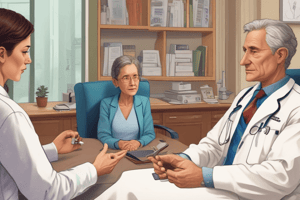Podcast
Questions and Answers
What is the primary purpose of paraphrasing in patient communication?
What is the primary purpose of paraphrasing in patient communication?
- To confirm the patient's medical knowledge.
- To provide detailed explanations of medical terms.
- To restate in other words to clarify meaning. (correct)
- To introduce new information.
Why should medical professionals avoid using abbreviations when communicating with patients?
Why should medical professionals avoid using abbreviations when communicating with patients?
- Abbreviations can create confusion. (correct)
- Abbreviations are universally understood.
- Patients are already familiar with all medical terms.
- Patients prefer detailed information without simplifications.
What is a key benefit of allowing productive silences during patient consultations?
What is a key benefit of allowing productive silences during patient consultations?
- It distracts the patient from their concerns.
- It allows time for the patient to fill the silence with irrelevant details.
- It keeps the conversation moving quickly.
- It encourages the patient to form new thoughts and organize ideas. (correct)
What is the purpose of summarizing the information shared by a patient?
What is the purpose of summarizing the information shared by a patient?
Which statement best summarizes the approach to clarifying communication with patients?
Which statement best summarizes the approach to clarifying communication with patients?
What is the main purpose of active listening in a healthcare setting?
What is the main purpose of active listening in a healthcare setting?
Which of the following aspects is NOT a component of the 'Medications' category in the information-gathering tools?
Which of the following aspects is NOT a component of the 'Medications' category in the information-gathering tools?
Which cue is essential for recognizing incongruence in a patient's communication?
Which cue is essential for recognizing incongruence in a patient's communication?
What is the intention behind reflective responses during patient communication?
What is the intention behind reflective responses during patient communication?
What does gating refer to in the context of active listening?
What does gating refer to in the context of active listening?
What type of questions typically elicit short, specific responses?
What type of questions typically elicit short, specific responses?
Which of the following is a key characteristic of open-ended questions?
Which of the following is a key characteristic of open-ended questions?
Which questioning approach might unintentionally lead a respondent to a specific answer?
Which questioning approach might unintentionally lead a respondent to a specific answer?
What is the main purpose of algorithms in information-gathering?
What is the main purpose of algorithms in information-gathering?
Why should 'Why?' questions be avoided in patient interactions?
Why should 'Why?' questions be avoided in patient interactions?
What should a healthcare provider avoid when leading the conversation?
What should a healthcare provider avoid when leading the conversation?
Which of the following would be considered a closed-ended question?
Which of the following would be considered a closed-ended question?
Which acronym's purpose is best described by the following: it provides an initial framework but may require adjustment in conversation?
Which acronym's purpose is best described by the following: it provides an initial framework but may require adjustment in conversation?
What is the primary purpose of the patient interview?
What is the primary purpose of the patient interview?
Which of the following is an example of subjective information?
Which of the following is an example of subjective information?
What is the role of summarizing patient information during an interview?
What is the role of summarizing patient information during an interview?
Which characteristic is most important when setting the stage for a patient interview?
Which characteristic is most important when setting the stage for a patient interview?
How would you categorize a question that allows a patient to give a detailed response, such as 'Can you describe your pain?'?
How would you categorize a question that allows a patient to give a detailed response, such as 'Can you describe your pain?'?
Which of the following statements is true about active listening?
Which of the following statements is true about active listening?
What should a health care provider do when greeting a patient to set a positive tone?
What should a health care provider do when greeting a patient to set a positive tone?
Flashcards
Patient Interview
Patient Interview
A conversation between a healthcare professional (HCP) and a patient to gather relevant information.
Chief Complaint (CC)
Chief Complaint (CC)
The primary reason a patient seeks medical attention. It's the most concerning symptom.
Subjective Information
Subjective Information
Information gathered from the patient's own experience, like feelings or symptoms.
Objective Information
Objective Information
Signup and view all the flashcards
Open-Ended Questions
Open-Ended Questions
Signup and view all the flashcards
Closed-Ended Questions
Closed-Ended Questions
Signup and view all the flashcards
Active Listening
Active Listening
Signup and view all the flashcards
Summarizing Information
Summarizing Information
Signup and view all the flashcards
Paraphrasing
Paraphrasing
Signup and view all the flashcards
Clarifying
Clarifying
Signup and view all the flashcards
Productive Silences
Productive Silences
Signup and view all the flashcards
Summarizing
Summarizing
Signup and view all the flashcards
Examples
Examples
Signup and view all the flashcards
MEDICATIONS, DIET, VISITS, INJURIES, SYMPTOMS, INFORMATION, TREATMENTS
MEDICATIONS, DIET, VISITS, INJURIES, SYMPTOMS, INFORMATION, TREATMENTS
Signup and view all the flashcards
Reflective Response
Reflective Response
Signup and view all the flashcards
Incongruence in Communication
Incongruence in Communication
Signup and view all the flashcards
Gating
Gating
Signup and view all the flashcards
Algorithms
Algorithms
Signup and view all the flashcards
Acronym
Acronym
Signup and view all the flashcards
Leading questions
Leading questions
Signup and view all the flashcards
"Why" questions
"Why" questions
Signup and view all the flashcards
Leading the conversation
Leading the conversation
Signup and view all the flashcards
Study Notes
Gathering Information - Chapter 2
- Learning Objectives:
- Define the patient interview and explain its purpose.
- List practices to prepare for a successful patient interview.
- Contrast subjective and objective information.
- Differentiate between open-ended and closed-ended questions and provide examples of each.
- Discuss the tools used to gather patient information.
- Discuss active listening.
- List the types of responses that support effective communication.
- Discuss the importance of summarizing patient information.
The Patient Interview
- Conversation between healthcare professional (HCP) and patient (pt) to gather relevant information.
- Covers:
- Patient's chief complaint.
- Patient's medical history.
- Medications.
- Family history.
- Review of systems (ROS).
- Line of questioning may change based on medical condition and chief complaint.
- Patient information is confidential and private and can only be shared with the patient's consent.
Setting the Stage
- Create a comfortable and private environment.
- Greet the patient properly.
- Introduce yourself with your name and title.
- Offer a handshake if appropriate.
- Sit at the patient's eye level.
- Use open body language (e.g., smiling, nodding)
- Maintain good personal hygiene.
Gathering Patient Information
- Subjective: Information experienced by the individual, including:
- Symptoms and current complaints.
- Chief complaint (C.C.): Most significant or serious reason for concern.
- Onset of problem.
- Location of complaint.
- Duration of problem.
- Pain (measured on pain scale)
- Quality of pain (e.g., sharp, dull, throbbing).
- Objective: Observable and measurable information, such as:
- Bloodwork.
- Lab results.
- Heart rate.
- Blood pressure (BP).
Getting to the Point
- Open-ended questions: Allow for detailed responses.
- Start with "what" or "how" to elicit detailed answers.
- Cannot be answered simply with "yes" or "no."
- Avoid using "why" (it can imply blame).
- Closed-ended questions: Limit the patient's response.
- Elicit short answers (e.g., "How many pills do you take?").
- Used for clarification or reassurance.
Obtaining a History
- How may we help you?
- Describe the... (pain, sensation, bleeding, etc.)?
- How long has this been bothering you?
- What happened to cause you to ask for help?
- Has it happened in the past? What did you do about it that time?
- Does anything make it better or worse?
- Have you taken anything?
Leading the Way
- Healthcare professionals (HCPs) may need to subtly refocus the conversation.
- Avoid leading questions.
- Leading questions: Encourage or expect a specific response (e.g., "You never had unprotected sex, did you?").
- Cuing: Inadvertently eliciting a desired response (positive or negative feedback to encourage a certain answer).
- Example: "How is your hand today?"
Information-Gathering Tools
- Algorithms: Step-by-step procedures for problem-solving. Use a logical progression. Question path can change based on patient's responses at each step. May be too focused or general in certain situations.
- Acronyms: Simple phrases composed of initial letters of words. May not replace the importance of adjusting questions to patient situations.
- Example Acronym (general visit):
- Medications: What medicines do you take, how much.
- Diet: Daily diet, recent weight gain or loss.
- Visits: Any recent ER visits, or similar.
- Injuries: Recent injuries.
- Symptoms: Any new symptoms.
- Information: Questions about treatment.
- Treatments: Treatment history
Listening to What You Hear
- Active Listening: Focused attention to comprehend, respond, and remember what the speaker says.
- Recognize verbal and nonverbal cues.
- Consciously block out distractions. (Gating).
- Active listening: Takes time and effort to improve.
- Cues: Spoken words, paralanguage, and body language are all important to consider.
- Incongruence: Discrepancies between verbal and nonverbal cues.
- Pt's chief complaint (C.C.): Not always the primary issue.
Reflective or Paraphrasing Responses
- Reflective responses: Confirming understanding without directly repeating.
- Paraphrasing: Restating in different words to clarify.
- Example: Pt says "Nothing has any taste"
- Paraphrase: "You are saying your food does not taste how you feel it should?"
Clarifying
- Clarifying: Removing confusion by ensuring clear communication of patient's statements and health professional's messages/actions.
- Abbreviations/Medical terms can be confusing.
- Ask the patient to use examples.
Productive Silences
- Sometimes, silence is helpful.
- Allow time for the patient to:
- Form new thoughts.
- Organize ideas.
- Remember events.
- Silence can improve observation.
Summarizing the Information
- Summarizing: Restating information briefly.
- Highlights main points.
- Allows patients to clarify concerns.
- Shows understanding.
- Ensures concerns are covered.
Studying That Suits You
Use AI to generate personalized quizzes and flashcards to suit your learning preferences.



